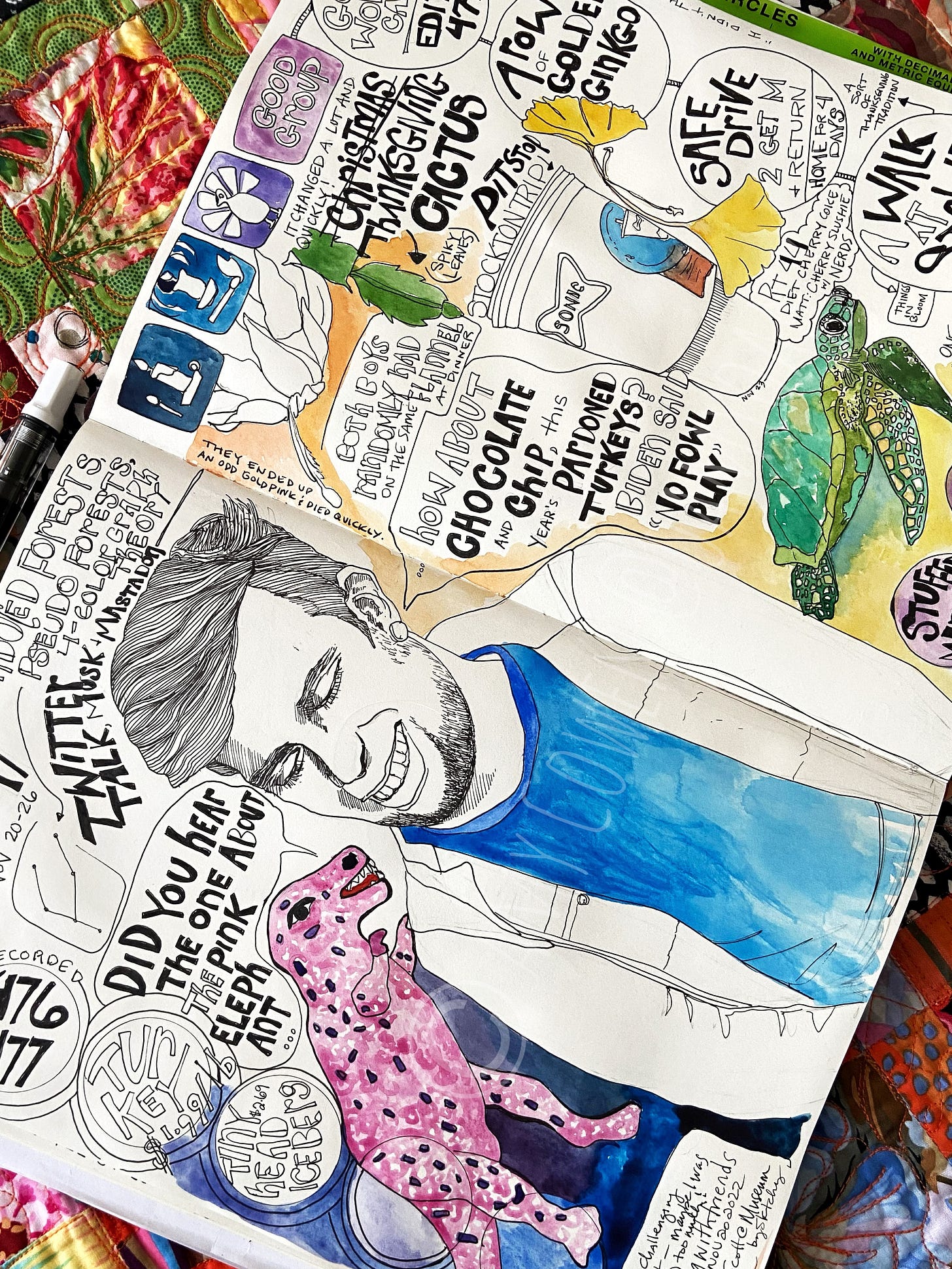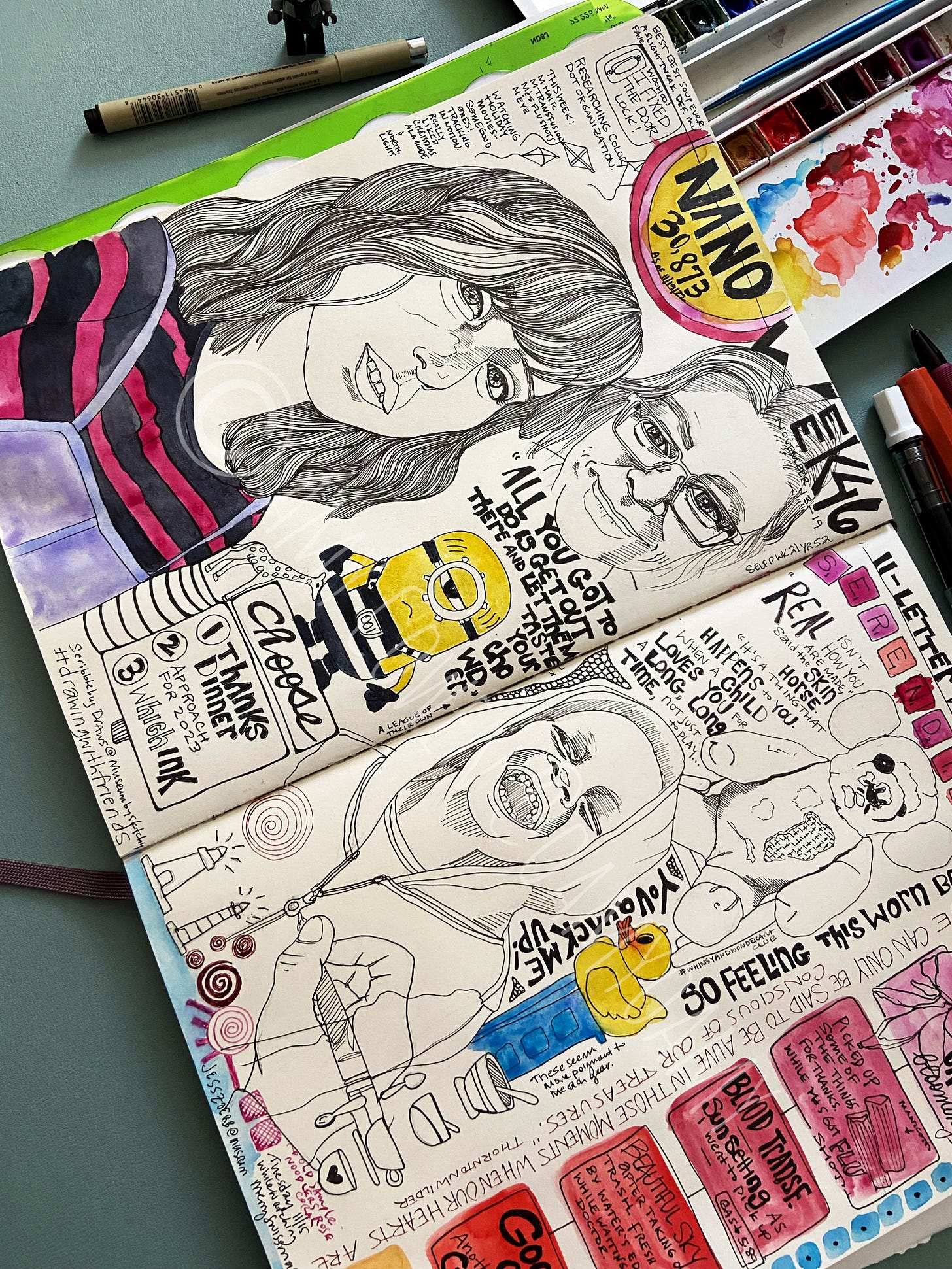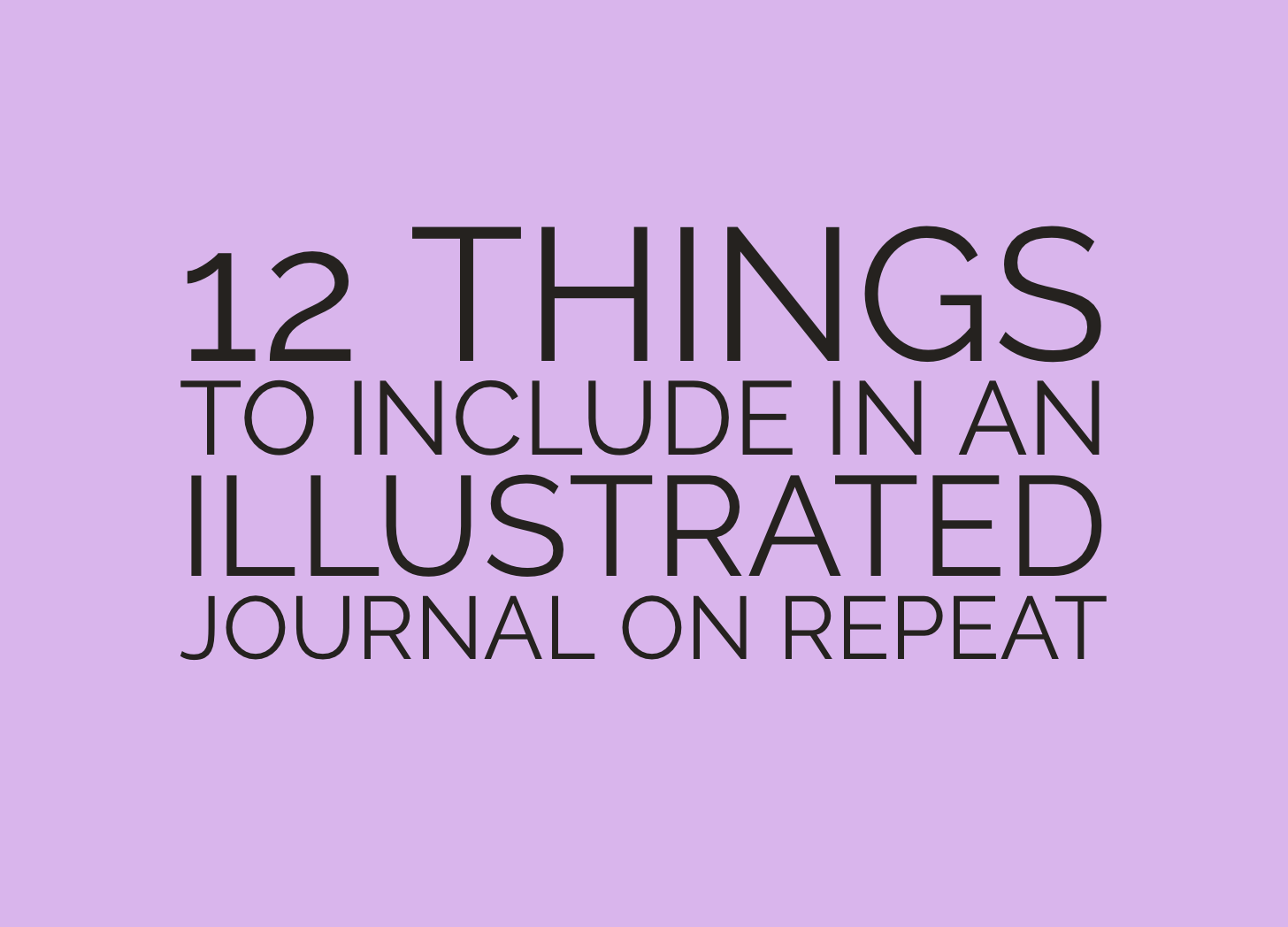12 Things to Include in Your Illustrated Journal
12 types of daily-life content you can include in your illustrated journal and that you can pick and choose from, on repeat.
When working on explaining the ins and outs of keeping an illustrated journal, there are all kinds of angles and layers, little drawers one can open, each full of colorful and thought-provoking threads about how things work, how they can work, and how you might approach starting and keeping your illustrated journal. The whole process is beautiful and tantalizing.
On the one hand, I always stress how personal and flexible the act of keeping an illustrated journal (or illustrated diary, or sketchnote diary, or visual journal, or whatever term you prefer) is. There are an infinite number of approaches one can take for keeping an illustrated journal. It is a personal and flexible project, one that has only the rules you give it. Because your life provides the foundation and context for your journal, most of the “fodder” you sift through each day or each week when deciding what to include is unique to you. This reinforces a simple underlying truth: your illustrated journal is something only you can write.
Even when people use the Illustrate Your Week prompts to help guide, inspire, and fill in sections of their personal recording, every page, every spread, every accumulation of marks and notes over the course of a week, will (and should) be different. Not only does our individual voice have a lot to do with how we arrange and fill our pages, but our details are different. Our contexts are different. The minutiae that make up our days are different. Our personal journals are records of our individual lives. They should look, sound, feel, and read like us, and the content should be from our days, our memories, our wishes, wants, and hopes.
At the same time, there are types of prompts, types of questions, types of documentation and tracking and recording that we can all make use of when filling our pages. The weekly Illustrate Your Week prompts are designed to give nudges that you can take in your own direction, connect to your own life in meaningful ways. Mixed in with prompts that might be tied to specific dates on the calendar are prompts that repeat.
There are many, many repeatable elements you can use to help anchor your pages week to week. Daily life, after all, has patterns, is marked by routines, and moves, mostly, in relatively consistent patterns.

A Formula for Keeping an Illustrated Journal
Even if you enjoy the sense that there are few rules you have to follow and no required tools or materials list for keeping an illustrated journal, sometimes, when you are wanting to dive into something new, what you really want is a map. You just want someone to say, write this, draw this, add this. Do these things, and you'll create beautiful records of your days, weeks, and life. You want a formula, a recipe, a set of steps that will turn your efforts into something that resembles what you’ve seen and hope to create, what you envision, or what you aspire to make.
Maps are good.
The map of my day, however, won’t match yours. The details are not the same. Map in hand, you might end up lost, or you might find yourself looking so diligently for the cues and mile markers noted on the guide map that you overlook the beauty, the wonder, the whimsy, the symbols and meaning in your own days, when those are exactly the things an illustrated journal invites you to see, gather, transcribe, and record.
While there is no single map or recipe for keeping an illustrated journal of your life, there are things you can include, approaches you can take, and strategies you can adopt for working on your pages. One of the most important things to keep in mind is that when recording details of your days and weeks, your quotidian, there are things that repeat. Your habits, routines, and cycles all provide data and inspiration for your journal.
Sometimes, when you are wanting to dive into something new, what you really want is a map. You just want someone to say, write this, draw this, add this.
12 Things to Add to Your Illustrated Journal on Repeat
Here is a list of 12 things you might include every week or every now and then. Whether you already keep a journal of this sort or are curious about the process, this list contains just a few of the many day-to-day staples around which you can build your creative illustrated journal habit. These items are easy to fit into a small amount of space, and you might find that you always record them in the same way or that some weeks you illustrate details from this list and other weeks you simply include written or lettered notes. The freedom to mix up your approach helps keep the process fresh.
This a la carte list offers a cafeteria-style assortment of things you can include in a visual journal:
Food. You can record what you eat (or drink) each day. Or you might just occasionally record a special meal or treat. Some weeks, you might want to track what you eat every day for lunch or for dinner. Other weeks, you might record something you ate, a new recipe you tried, or even the packaging for something you ate. Jars, for example, can be especially fun to draw. Food is an easy staple for your journal. It has a place in your life every day, and it offers plenty of opportunity for “everyday matters”-style drawings.
A habit tracker. Adding a small habit tracker to your pages is functional and adds visual texture to your pages. You might keep your tracker in another place, a bullet journal or planner for instance. But putting even a small tracker into your visual journal can work well and add some additional context and detail to your recording.
A daily summary. This is one I recommend you do with regularity. Writing a short note about the day, every day, helps anchor your journal, gives it weight and meaning and markers of memory. You can experiment with what shape the note takes and how long it is, but definitely try adding these notes.
A mood rating for the day. How you record this might vary week to week, but you may find it helpful to stop at a certain time of the day and give the day some valuation (a number, a set of stars or symbols, a letter, etc.). If you are also recording a daily summary, you might add the mood rating or "rank" the day at the same time.
What you are reading, watching, or listening to. This might include TV, videos, audiobooks, podcasts, music, playlists, books, and more. There are an infinite number of ways you might capture this information on your pages, but these categories are frequently in flux. Capturing what TV shows or series you watch each week, for example, helps anchor your pages in a particular moment in time. If you are trying to include more illustrations, you might draw book covers or podcast icons or even characters.
Appointments, celebrations, milestones, and other events. Record the actual things that happen.
News or updates. Breaking news is always good to record, whether it's from your microcosm (something that affects you, your family, or friends, for instance) or whether it's news at a broader level. What are the headlines this week?
Something you saw. This staple prompt lends itself either to writing or to illustrating. It also subtly reminds you to be actively looking as you move through your days. Even if you are home most of the time, there are things to see, either in your space or through a window. Look, and be inspired by what you see.
Something that made you smile (or laugh). This sounds like a simple one, but I have found this to be a difficult one and, because it is difficult, one I often stop to think about. Jot down the moments that make you smile or laugh. Every once in a while, make this something you try to record every day for a week. It can create a beautiful record.
Clothes. You can include what you wore on a specific day, or some weeks you might want to document what you wear every day.
The weather. Some people track weather as a part of every day. You can easily do that in your illustrated journal, too. As with everything else, you might just record the temperature, but you might use another system to visually record or track this information.
A short to-do list (daily or weekly). Your illustrated journal doesn't have to serve double-duty as a planner or bullet journal. But you might still enjoy starting the week by noting a few things that need to happen, either for the day or the week or the month.
These are all very simple things you can add to your pages. This is in no way an exhaustive list. I just thought I would share some of the basics, the staples of daily living that are always available when you are trying to record something concrete from your day.
Thinking of this cafeteria-style offers a really good analogy. You can look at this list and pick and choose a few things you might want to use this week. You might choose a different subset next week. Every week you can mix things up. Or, you might find that you really enjoy always including certain things from this list. Those items become part of how you approach your journal.
Deciding what to put on your pages doesn't have to be a stumbling block! Pick one or two of these items to mix in next week.
I’ll be sharing other lists to help you think in really concrete terms about your illustrated journal. Which of these do you often include?
A la carte: listing or serving food that can be ordered as separate items, rather than part of a set meal. (Google's English Dictionary)
A la carte: according to a menu or list that prices items separately. (Merriam-Webster)

Mental bird walk…. Writing about cafeterias always makes me think of a restaurant we went to when I was a kid. I have very few childhood memories, but something about going through the cafeteria line at a restaurant called Piccadilly always wafts to the surface when I think about choosing things a la carte. It is somewhere my family ate frequently. I only have wisps of the memory, but enough to know it is soft. Cafeteria-style can be good. (This must be the restaurant. It's been more than 45 years since I would have been at one, but the memory came up tonight, and a quick search shows me they still exist.)
Because your life provides the foundation and context for your journal, most of the “fodder” you sift through each day or each week when deciding what to include is unique to you. This reinforces a simple underlying truth: your illustrated journal is something only you can write.
Amy Cowen
Feedback time: I added a few examples in this post. Good idea? Or do you really just prefer reading the info without the images? I’m curious. Weigh in below!
(Confused why you didn’t get an email about this? I am hoping to put out some content that doesn’t fill your inbox. I’ll be linking to pieces like this from my Simply Sunday email. So you will get a newsletter to your in-box, but it might just contain a highlight of this post so that you can jump over here to read the full thing.)






The pictures always compliment the writing ❤️
Thank you for all these great ideas. I’ve been keeping a daily journal since 1977. I always add the weather, what I’m reading, watching, or listening to, good, and what I did. But your prompts and suggestions just made me add more details to the last few days. I always kept emotions out of it (wrote them elsewhere) but I’m going to add wishes and hopes and longings now.